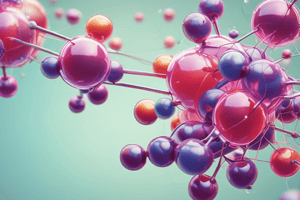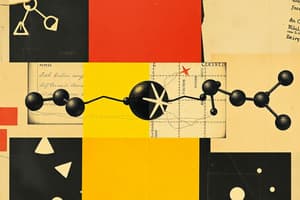Podcast
Questions and Answers
What is one of the most important classifications for molecules mentioned in the text?
What is one of the most important classifications for molecules mentioned in the text?
- Acidic or alkaline
- Organic or inorganic
- Solid or liquid
- Polar or non-polar (correct)
What is the speaker's opinion about polar molecules?
What is the speaker's opinion about polar molecules?
- They are less symmetrical
- They are less useful
- They are less common
- They are more interesting (correct)
Based on the experiment with butter and water, why does the butter not wash off the speaker's hand?
Based on the experiment with butter and water, why does the butter not wash off the speaker's hand?
- It is non-polar and repels the water (correct)
- It is chemically bonded to the skin
- It is solid at room temperature
- It is polar and attracts the water
What is the result of mixing water with alcohol?
What is the result of mixing water with alcohol?
What is the reason behind ice having a volume 10% larger than water?
What is the reason behind ice having a volume 10% larger than water?
What is the major characteristic of water at 4 °C?
What is the major characteristic of water at 4 °C?
What allows water to dissolve more compounds than any other chemical on Earth?
What allows water to dissolve more compounds than any other chemical on Earth?
What is one of the requirements for a molecule to be polar?
What is one of the requirements for a molecule to be polar?
What is the role of geometrical asymmetry in determining polarity?
What is the role of geometrical asymmetry in determining polarity?
What is the effect of polarity on the ability of liquids to dissolve solids?
What is the effect of polarity on the ability of liquids to dissolve solids?
Flashcards
Polar molecule
Polar molecule
A molecule with an uneven distribution of electrical charge, resulting in a positive and negative end.
Non-polar molecule
Non-polar molecule
A molecule with an even distribution of electrical charge, having no distinct positive or negative ends.
Solubility
Solubility
The ability of a substance to dissolve another substance.
Electronegativity
Electronegativity
Signup and view all the flashcards
Geometrical asymmetry
Geometrical asymmetry
Signup and view all the flashcards
Hydrogen bonding
Hydrogen bonding
Signup and view all the flashcards
Density
Density
Signup and view all the flashcards
Density of water at 4 °C
Density of water at 4 °C
Signup and view all the flashcards
Universal solvent
Universal solvent
Signup and view all the flashcards
Expansion of water upon freezing
Expansion of water upon freezing
Signup and view all the flashcards
Study Notes
Understanding Polarity in Molecules
- Water is a polar molecule, whereas the chemicals in butter are non-polar, leading to a lack of interaction between them.
- A molecule is polar if it has asymmetrical electron distribution and is made up of different elements with a significant difference in electronegativities.
- Electronegativity is the ability of an atom to attract shared electrons, and it increases from left to right and decreases from top to bottom in the periodic table.
- For a molecule to be polar, it needs to have two different elements with an electronegativity difference of 0.5 or greater.
- Polarity results in a partially negative charge on the more electronegative part of the molecule and a partially positive charge on the less electronegative side.
- Geometrical asymmetry is also necessary for a molecule to be polar.
- Molecules with polar bonds may not be polar themselves if the symmetry of the bonds cancels out the asymmetry of the charges.
- Polarity is indicated by a dipole moment, which is a separation of the charge around the molecule into a more positive and a more negative area.
- Liquids made up of polar molecules are effective at dissolving solids composed of polar or ionic compounds.
- Ionic solids involve a complete transfer of electrons, creating two charged ions, and are an extreme form of polarity.
- The arrangement of partial positive and partial negative charges in water is at its lowest energy state when they line up together, positive to negative, into a liquid crystal.
- The strength of surface tension in water depends on intermolecular forces that pull molecules of a liquid together, and cohesive forces minimize surface area in the liquid.
Studying That Suits You
Use AI to generate personalized quizzes and flashcards to suit your learning preferences.




